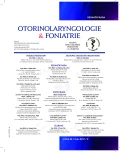Indications and Performance of Dacryocystorhinostomies in Child Patients
Authors:
I. Šlapák 1; M. Máchalová 1; R. Autrata 2; M. Lokaj 2; A. Kaliariková 1
Authors‘ workplace:
Klinika dětské otorinolaryngologie FN Brno
1; Dětská oční klinika FN Brno
2
Published in:
Otorinolaryngol Foniatr, 66, 2017, No. 3, pp. 115-118.
Category:
Original Article
Overview
Disorders of the lacrimal system are usually diagnosed and treated in the departments of ophthalmology without surgery. Surgical treatment is provided by an endoscopic endonasal technique in the otolaryngology departments. The most frequent symptoms are excessive lacrimation, frequent inflammation and swelling in the inner eye corner. The type of obstruction of lacrimal system is divided according to localization of blockage into: presacral, sacral and subsacral. Dacryocystorhinostomy (DCR) is the most frequent surgical technique which is used to replace the lacrimal system. A retrospective study of indications, surgical techniques and the results of performed operations was carried out in KDORL LF MU and FN Brno on a group of patients between 2009 – 2015. Fifty operations were performed in all. The main indication of DCR was a congenital obstruction of the lacrimal pathways. A few patients were operated on because of post-traumatic obstruction. During operations a 4 mm rigid endoscope optic with 0 angle lens were used. Before and during operation tampons with solution of adrenaline for nasal mucosa were applied. During the operation, a lacrimal puncture with probe was used to insert a silicon fiber, which was then knotted in the nasal cavity. At the end of the operation a small anterior nasal packing was inserted. This was removed next day. In the last two years, a Thulium laser was used during operations that significantly decreased bleeding, so it was not necessary to use anterior nasal packing. Using a Thulium laser also enables bilateral operation at one time if necessary, for breast-feeding infants. The silicon fibre was usually removed after 3-4 months. Silicon fiber is removed from the nasal cavity or inner eye corner by pulling it together with the small knot. In the case of re -occurrence, when a blockage of the lacrimal ducts appeared again, the silicon fiber was kept in place for more than one year. During this period of 7 years, 22 DCR were performed on girls and 28 on boys. There were in 2009: 3; 2010: 7; 2011: 12; 2012: 4; 2013: 10; 2014:10; 2015:4, i.e. a total of 50 operations. Twenty-eight DCR operations were performed on the age group 0-1 year included 15 operations on girls and 13 operations on boys. In the age group 1-3 years fourteen operations were performed: 5 on girls and 9 on boys. In the age group 6-year-olds, 1 boy was operated on and in the group 8-year-olds also 1 boy. In the 9-year-olds group 2 boys and 1 girl were operated on. During this period one 10-year-old girl was operated on, one 11-year-old boy and one 13-year-old boy. Right side DCR operations were performed in 26 cases; left side in 24 cases. Bilateral operation was performed in 6 cases. In 6 cases (12%) revision surgery was provided because of repeated blockage of the lacrimal duct. The most common rhinoscopy finding was a scarring after an operation performed to open the lacrimal duct. This was especially so in children with multiple craniofacial anomalies.
Keywords:
endoscopic endonasal dacryocystorhinostomy, indications, performance
Sources
1. Akcay, E., Yuksel, N., Ozen, U.: Revision external dacryocystorhinostomy results after a failed dacryocystorhinostomy Surgery. Ophthalmol. Ther., 5, 2016, 1, s. 75-80. doi: 10.1007/s40123-016-0048-4. Epub 2016 Apr 13.
2. Allen, K., Berlin, A. J.: Dacryocystorhinostomy failure: association with nasolacrimal silicone intubation. Ophtalmic Surg., 20, 1989, s. 486-489.
3. Herzallah, I., Alzuraiqi, B., Bawazeer, N., Marglani, O., Alherabi, A., Mohamed, S. K., Al-Qahtani, K., Al-Khatib, T., Alghamdi, A.: Endoscopic dacryocystorhinostomy (DCR): a comparative study between powered and non-powered technique. J. Otolaryngol. Head Neck Surg., 22, 2015, s. 44-56, doi: 10.1186/s40463-015-0109-z.
4. Koch, K. R., Cursiefen, C., Heindl, L. M.: Transcanalicular laser dacryocystorhinostomy: One-year-experience in the treatment of acquired nasolacrimal duct obstructions]. Klin. Monbl. Augenheilkd., 233, 2016, 2, s. 182-2866. doi: 10.1055/s-0041-106653. Epub 2015 Nov 26. German.
5. Komínek, P., Červenka, S., Matoušek, P.: Endonasální dacryocystorinostomie – jak najít slzný vak? 2007.
6. Komínek, P., Červenka, S., Mullner, K.: Nemoci slzných cest – diagnostika a léčba. Maxdorf, Praha, 2003.
7. Komínek, P., Červenka, S.: Využití endoskopické techniky při řešení komplikovaných stavů vrozené neprůchodnosti odvodných slzných cest – obecná část (1). Otorinolaryngol. a Foniat. (Prague), 46,1997, s. 57-62.
8. Komínek, P., Červenka, S.: Využití endoskopické techniky při řešení komplikovaných stavů vrozené neprůchodnosti odvodných slzných cest – obecná část (2). Otorinolaryngol. a Foniat. (Prague), 46, 1997, s. 62-67.
9. Markalous, B., Charvát, F., Nejedlý, J., Zýková, E.: Rinitidy, sinusitidy a nosní polypy. Triton, 2009, 405 stran, ISBN 978-80-7387-1.
10. Muscatello, L., Giudice, M., Spriano, G., Tončini, L.: Endoscopic dacryocystorhinostomy: personal experience. Acta Otorhinolaryngol., 25 2005, 4, s. 209-213.
11. Nuhoglu, F., Gurbuz, B., Eltutar, K.: Long-term outcomes after transcanalicular laser dacryocystorhinostom. Acta Otorhinolaryngol., 32, 2012, 4, s. 258-262.
12. Onerci, M., Orhan, M., Ogretmenoglu, O. et al.: Long-term results and reasons for failure of intranasal endoscopic dacryocystorhinostomy. Acta Otolaryngol., 120, 200, s. 319-322.
13. Šlapák, I. a kolektiv: Dětská otorinolaryngologie. Mladá fronta, 2013, 333 stran, ISBN 978-80-204-2900-1.
14. Wu, W., Cannon, P. S., Yan, W., Tu, Y., Selva, D., Qu, J.: Effects of merogel coverage on wound healing and ostial patency in endonasal endoscopic dacryocystorhinostomy for primary chronic dacryocystitis. Eye, 25, 2011, 6, s. 746-753.
Labels
Audiology Paediatric ENT ENT (Otorhinolaryngology)Article was published in
Otorhinolaryngology and Phoniatrics

2017 Issue 3
Most read in this issue
- Treatment of Idiopathic Sudden Sensorineural Hearing Loss - Hyperbaric Oxygen Therapy
- Guidelines for Diagnosis and Treatment of Parotid Gland Tumours
- Adenoid Cystic Carcinoma of the Auricle
- Non-tramatic Rhinorrhea
